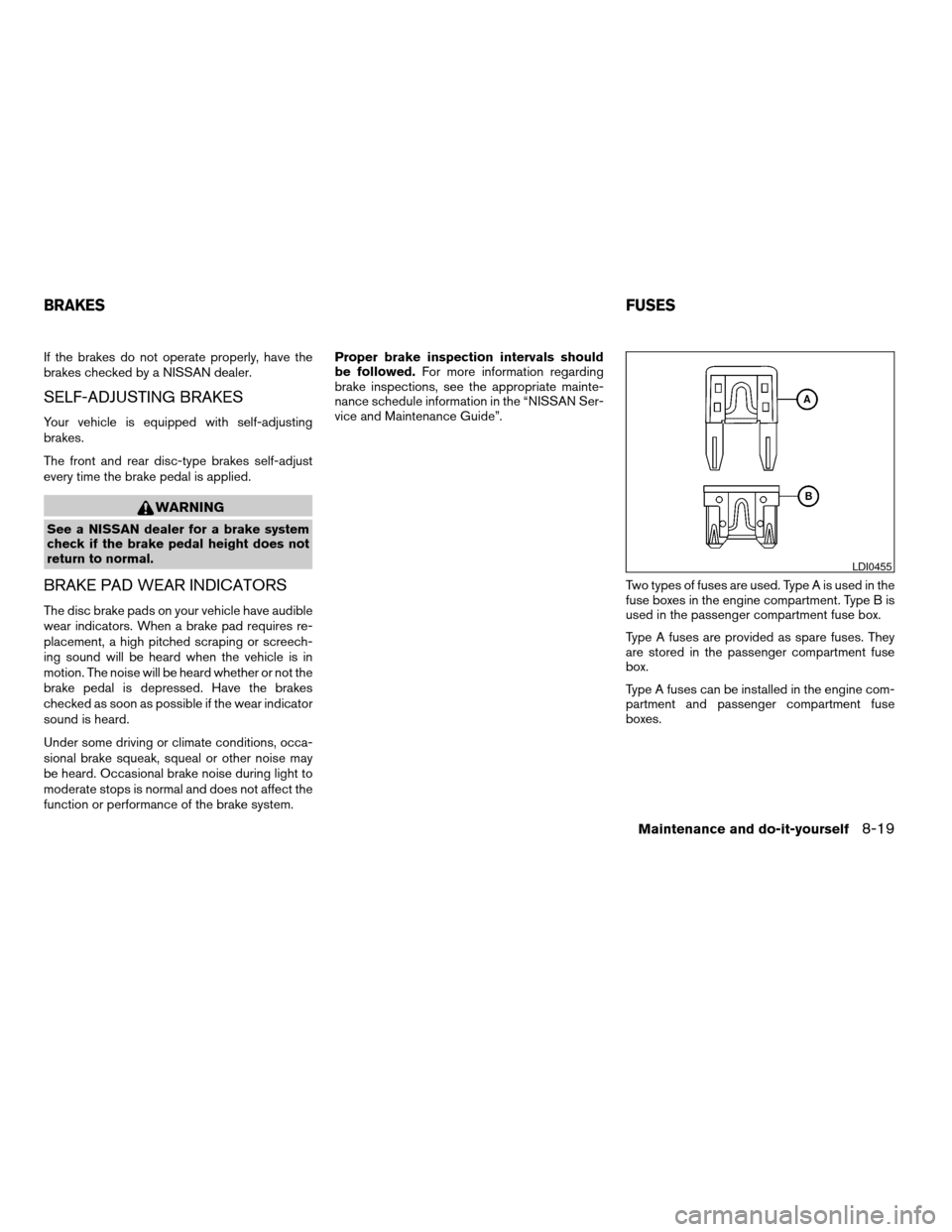2008 NISSAN ALTIMA HYBRID brakes
[x] Cancel search: brakesPage 272 of 351

When driving in areas using road salt or other
corrosive materials, check lubrication frequently.
Lights*Clean the headlights on a regular basis.
Make sure that the headlights, stop lights, tail
lights, turn signal lights, and other lights are all
operating properly and installed securely. Also
check headlight aim.
Road wheel nuts (lug nuts)*When checking
the tires, make sure no wheel nuts are missing,
and check for any loose wheel nuts. Tighten if
necessary.
Tire rotation*Tires should be rotated every
7,500 miles (12,000 km) .
Tires*Check the pressure with a gauge often
and always prior to long distance trips. If neces-
sary, adjust the pressure in all tires, including the
spare, to the pressure specified. Check carefully
for damage, cuts or excessive wear.
Tire Pressure Monitoring System (TPMS)
transmitter componentsReplace the grom-
met seal, valve core and cap of the transmitter in
vehicles equipped with TPMS at tire replacement
when reaching the wear limit of the tires.
Wheel alignment and balanceIf the vehicle
should pull to either side while driving on a
straight and level road, or if you detect uneven or
abnormal tire wear, there may be a need for wheelalignment. If the steering wheel or seat vibrates at
normal highway speeds, wheel balancing may be
needed.
cFor additional information regarding tires,
refer to “Important Tire Safety Information”
(US) or “Tire Safety Information” (Canada) in
the Warranty Information Booklet .
WindshieldClean the windshield on a regular
basis. Check the windshield at least every six
months for cracks or other damage. Have a dam-
aged windshield repaired by a qualified repair
facility.
Windshield wiper blades*Check for cracks or
wear if they do not wipe properly.
Inside the vehicle
The maintenance items listed here should be
checked on a regular basis, such as when per-
forming periodic maintenance, cleaning the ve-
hicle, etc.
Additional information on the following
items with an “*” is found later in this sec-
tion.
Accelerator pedalCheck the pedal for smooth
operation and make sure the pedal does not bind
or require uneven effort. Keep the floor mat away
from the pedal.Brake pedalCheck the pedal for smooth opera-
tion. If the brake pedal suddenly goes down fur-
ther than normal, the pedal feels spongy or the
vehicle seems to take longer to stop, see a
NISSAN dealer immediately. Keep the floor mat
away from the pedal.
BrakesCheck that the brakes do not pull the
vehicle to one side when applied.
Electronically controlled Continuously
Variable Transmission (eCVT) P (Park) po-
sition mechanism:On a fairly steep hill check
that the vehicle is held securely with the selector
lever in the P (Park) position without applying any
brakes.
Parking brakeCheck the parking brake opera-
tion regularly. The vehicle should be securely held
on a fairly steep hill with only the parking brake
applied. If the parking brake needs adjustment,
see a NISSAN dealer.
SeatsCheck seat position controls such as seat
adjusters, seatback recliner, etc. to ensure they
operate smoothly and all latches lock securely in
every position. Check that the head restraints
move up and down smoothly and the locks (if so
equipped) hold securely in all latched positions.
Seat beltsCheck that all parts of the seat belt
system (for example, buckles, anchors, adjusters
and retractors) operate properly and smoothly,
Maintenance and do-it-yourself8-3
ZREVIEW COPYÐ2008 Altima Hybrid Electric
(ahv)
Owners ManualÐUSA_English(nna)
05/31/07Ðdebbie
X
Page 288 of 351

If the brakes do not operate properly, have the
brakes checked by a NISSAN dealer.
SELF-ADJUSTING BRAKES
Your vehicle is equipped with self-adjusting
brakes.
The front and rear disc-type brakes self-adjust
every time the brake pedal is applied.
WARNING
See a NISSAN dealer for a brake system
check if the brake pedal height does not
return to normal.
BRAKE PAD WEAR INDICATORS
The disc brake pads on your vehicle have audible
wear indicators. When a brake pad requires re-
placement, a high pitched scraping or screech-
ing sound will be heard when the vehicle is in
motion. The noise will be heard whether or not the
brake pedal is depressed. Have the brakes
checked as soon as possible if the wear indicator
sound is heard.
Under some driving or climate conditions, occa-
sional brake squeak, squeal or other noise may
be heard. Occasional brake noise during light to
moderate stops is normal and does not affect the
function or performance of the brake system.Proper brake inspection intervals should
be followed.For more information regarding
brake inspections, see the appropriate mainte-
nance schedule information in the “NISSAN Ser-
vice and Maintenance Guide”.
Two types of fuses are used. Type A is used in the
fuse boxes in the engine compartment. Type B is
used in the passenger compartment fuse box.
Type A fuses are provided as spare fuses. They
are stored in the passenger compartment fuse
box.
Type A fuses can be installed in the engine com-
partment and passenger compartment fuse
boxes.
LDI0455
BRAKESFUSES
Maintenance and do-it-yourself8-19
ZREVIEW COPYÐ2008 Altima Hybrid Electric
(ahv)
Owners ManualÐUSA_English(nna)
05/31/07Ðdebbie
X
Page 331 of 351

cAfter the hitch is removed, seal the bolt
holes to prevent exhaust fumes, water
or dust from entering the passenger
compartment.
cRegularly check that all trailer hitch
mounting bolts are securely mounted.
Tire pressures
cWhen towing a trailer, inflate the ve-
hicle tires to the recommended cold
tire pressure indicated on the Tire
and Loading Information label.
cTrailer tire condition, size, load rating
and proper inflation pressure should
be in accordance with the trailer and
tire manufacturer’s specifications.
Safety chains
Always use suitable safety chains between your
vehicle and the trailer. The safety chains should
be crossed and should be attached to the hitch,
not to the vehicle bumper or axle. Be sure to leave
enough slack in the chains to permit turning
corners.
Trailer lights
CAUTION
When splicing into the vehicle electrical
system, a commercially available power-
type module/converter must be used to
provide power for all trailer lighting. This
unit uses the vehicle battery as a direct
power source for all trailer lights while
using the vehicle tail light, stoplight and
turn signal circuits as a signal source. The
module/converter must draw no more
that 15 milliamps from the stop and tail
lamp circuits. Using a module/converter
that exceeds these power requirements
may damage the vehicle’s electrical sys-
tem. See a reputable trailer dealer to ob-
tain the proper equipment and to have it
installed.
Trailer lights should comply with federal and/or
local regulations. For assistance in hooking up
trailer lights, contact a NISSAN dealer or repu-
table trailer dealer.
Trailer brakes
If your trailer is equipped with a braking system,
make sure it conforms to federal and/or local
regulations and that it is properly installed.
WARNING
Never connect a trailer brake system di-
rectly to the vehicle brake system.
Pre-towing tips
cBe certain your vehicle maintains a level
position when a loaded and/or unloaded
trailer is hitched. Do not drive the vehicle if it
has an abnormal nose-up or nose-down
condition; check for improper tongue load,
overload, worn suspension or other possible
causes of either condition.
cAlways secure items in the trailer to prevent
load shift while driving.
cKeep the cargo load as low as possible in
the trailer to keep the trailer center of gravity
low.
cLoad the trailer so approximately 60% of the
trailer load is in the front half and 40% is in
the back half. Also make sure the load is
balanced side to side.
cCheck your hitch, trailer tire pressure, ve-
hicle tire pressure, trailer light operation, and
trailer wheel lug nuts every time you attach a
trailer to the vehicle.
9-20Technical and consumer information
ZREVIEW COPYÐ2008 Altima Hybrid Electric
(ahv)
Owners ManualÐUSA_English(nna)
05/31/07Ðdebbie
X
Page 333 of 351

cWhen making a turn, your trailer wheels will
be closer to the inside of the turn than your
vehicle wheels. To compensate for this,
make a larger than normal turning radius
during the turn.
cCrosswinds and rough roads will adversely
affect vehicle/trailer handling, possibly caus-
ing vehicle sway. When being passed by
larger vehicles, be prepared for possible
changes in crosswinds that could affect ve-
hicle handling.
Do the following if the trailer begins to sway:
1. Take your foot off the accelerator pedal to
allow the vehicle to coast and steer as
straight ahead as the road conditions allow.
This combination will help stabilize the ve-
hicle.
– Do not correct trailer sway by steering or
applying the brakes.
2. When the trailer sway stops, gently apply the
brakes and pull to the side of the road in a
safe area.
3. Try to rearrange the trailer load so it is bal-
anced as described earlier in this section.
cBe careful when passing other vehicles.
Passing while towing a trailer requires con-
siderably more distance than normal pass-ing. Remember, the length of the trailer must
also pass the other vehicle before you can
safely change lanes.
cDownshift the transmission to a lower gear
for engine braking when driving down steep
or long hills. This will help slow the vehicle
without applying the brakes.
cTo maintain engine braking efficiency and
electrical charging performance, do not use
overdrive.
cAvoid holding the brake pedal down too long
or too frequently. This could cause the
brakes to overheat, resulting in reduced
braking efficiency.
cIncrease your following distance to allow for
greater stopping distances while towing a
trailer. Anticipate stops and brake gradually.
cDo not use cruise control while towing a
trailer.
cSome states or provinces have specific
regulations and speed limits for vehicles that
are towing trailers. Obey the local speed
limits.
cCheck your hitch, trailer wiring harness con-
nections, and trailer wheel lug nuts after 50
miles (80 km) of travel and at every break.cWhen stopped in traffic for long periods of
time in hot weather, put the vehicle in the P
(Park) position.
cWhen launching a boat, don’t allow the wa-
ter level to go over the exhaust tail pipe or
rear bumper.
cMake sure you disconnect the trailer lights
before backing the trailer into the water or
the trailer lights may burn out.
When towing a trailer, eCVT fluid should be
changed more frequently. For additional
information, see the “Maintenance and do-
it-yourself” section earlier in this manual.
FLAT TOWING
Towing your vehicle with all four wheels on the
ground is sometimes called flat towing. This
method is sometimes used when towing a vehicle
behind a recreational vehicle, such as a motor
home.
Your vehicle is not designed to be flat towed with
all four wheels on the ground.
9-22Technical and consumer information
ZREVIEW COPYÐ2008 Altima Hybrid Electric
(ahv)
Owners ManualÐUSA_English(nna)
05/31/07Ðdebbie
X
Page 340 of 351

10 Index
12-volt battery..................8-15
A
Active Head Restraint..............1-6
Air bag (See supplemental restraint
system).....................1-34
Air bag system
Front (See supplemental front impact air
bag system).................1-41
Air bag warning light...........1-49, 2-14
Air cleaner housing filter............8-17
Air conditioner
Air conditioner service...........4-13
Air conditioner specification label.....9-11
Air conditioner system refrigerant and oil
recommendations..............9-6
Heater and air conditioner controls. . . .4-11
Servicing air conditioner..........4-13
Alarm system
(See vehicle security system).........2-26
Anchor point locations.............1-19
Antenna.....................4-38
Anti-lock brake warning light..........2-10
Anti-lock Braking System (ABS)........5-19
Armrests.....................1-5
Audible reminders................2-17
Audio system..................4-13
Compact Disc (CD) changer. . . .4-27, 4-33
Compact disc (CD) player.........4-22FM-AM radio with compact disc (CD)
player....................4-20
FM/AM/SAT radio with compact disc
(CD) changer.............4-25, 4-31
Radio....................4-13
Autolight switch.................2-30
Automatic
Automatic power window switch.....2-43
Transmission selector lever lock
release....................5-12
Automatic anti-glare inside mirror.......3-23
AUX jack..............4-23, 4-29, 4-35
B
Battery
Charge warning light........2-11, 2-12
Before starting the vehicle............5-9
Belt (See drive belt)..............8-15
Block heater
Engine....................5-23
BluetoothThands-free phone
system..................4-39, 4-53
Booster seats..................1-29
Brake
Anti-lock Braking System (ABS)......5-19
Brake fluid..................8-13
Brake light (See stop light).........8-25
Brake system................5-17
Brake warning light.........2-10, 2-11
Brake wear indicators........2-17, 8-19Parking brake operation..........5-13
Self-adjusting brakes............8-19
Brakes......................8-19
Break-in schedule................5-15
Brightness control
Instrument panel..............2-32
Brightness/contrast button...........4-7
Bulb check/instrument panel..........2-9
Bulb replacement................8-25
C
Capacities and recommended
fuel/lubricants...................9-2
Car phone or CB radio.............4-39
Cargo (See vehicle loading information) . . .9-12
CD care and cleaning.............4-36
CD changer (See audio system). . . .4-27, 4-33
CD player (See audio system).........4-22
Child restraint with top tether strap......1-18
Child restraints.......1-9, 1-10, 1-15, 1-17
Precautions on child
restraints............1-15, 1-23, 1-29
Top tether strap anchor point locations . .1-19
Child safety rear door lock............3-5
Chimes, audible reminders...........2-17
Cleaning exterior and interior..........7-2
Clock.............4-5, 4-21, 4-25, 4-31
(models with navigation system)......4-5
(models without navigation
system)................4-21, 4-25
ZREVIEW COPYÐ2008 Altima Hybrid Electric
(ahv)
Owners ManualÐUSA_English(nna)
05/31/07Ðdebbie
X
Page 344 of 351

Precautions on seat belt usage.......1-7
Precautions on supplemental restraint
system....................1-34
Precautions when starting and driving . . .5-2
Programmable features.............4-3
Push starting..................6-10
R
Radio
Car phone or CB radio...........4-39
Compact Disc (CD) changer. . . .4-27, 4-33
FM-AM radio with compact disc (CD)
player....................4-20
FM/AM/SAT radio with compact disc
(CD) changer.............4-25, 4-31
Readiness for inspection maintenance (I/M)
test........................9-25
Rear power windows..............2-43
Rear view monitor................4-8
Rear window and outside mirror defroster
switch......................2-29
Recorders
Event data..................9-25
Refrigerant recommendation..........9-6
Registering your vehicle in another country. . .9-9
Reporting safety defects (US only)......9-24
S
Safety
Child safety rear door lock..........3-5
Child seat belts........1-15, 1-23, 1-29
Reporting safety defects (US only). . . .9-24Seat adjustment
Front manual seat adjustment........1-2
Front power seat adjustment........1-4
Seat belt
Child safety..................1-9
Infants and small children.........1-10
Injured Person................1-11
Larger children...............1-10
Precautions on seat belt usage.......1-7
Pregnant women..............1-11
Seat belt extenders.............1-14
Seat belt maintenance...........1-14
Seat belts...................1-7
Shoulder belt height adjustment......1-14
Three-point type with retractor.......1-11
Seat belt warning light.............2-14
Seatback pockets................2-37
Seats
Adjustment..................1-2
Front seats..................1-2
Heated seats................2-34
Manual front seat adjustment........1-2
Security system (NISSAN vehicle immobilizer
system) , engine start...........2-27, 5-9
Self-adjusting brakes..............8-19
Service manual order form...........9-26
Servicing air conditioner............4-13
Setup button...................4-3
Shift lock release................5-12
Shifting
Electronically controlled Continuously
Variable Transmission (eCVT).......5-11
Shoulder belt height adjustment........1-14
Spark plug replacement............8-16
Speedometer...................2-3
Spotlights (See map light)...........2-46SRS warning label...............1-49
Starting
Before starting the vehicle..........5-9
Jump starting.................6-7
Precautions when starting and driving . . .5-2
Push starting................6-10
Starting the vehicle.............5-10
Startup screen..................4-3
Steering
Power steering system...........5-17
Stop light....................8-25
Storage.....................2-36
Sun visors....................3-22
Sunglasses case................2-37
Sunglasses holder...............2-37
Sunroof.....................2-44
Supplemental air bag warning light . . .1-49, 2-14
Supplemental front impact air bag system . .1-41
Supplemental restraint system
Information and warning labels.......1-49
Precautions on supplemental restraint
system....................1-34
Supplemental restraint system
(Supplemental air bag system).........1-34
Switch
Autolight switch...............2-30
Automatic power window switch.....2-43
Fog light switch...............2-33
Hazard warning flasher switch.......2-33
Headlight and turn signal switch......2-29
Headlight control switch..........2-29
Power door lock switch...........3-5
Rear window and outside mirror defroster
switch....................2-29
Turn signal switch..............2-33
Windshield wiper and washer switch . . .2-28
10-5
ZREVIEW COPYÐ2008 Altima Hybrid Electric
(ahv)
Owners ManualÐUSA_English(nna)
05/31/07Ðdebbie
X